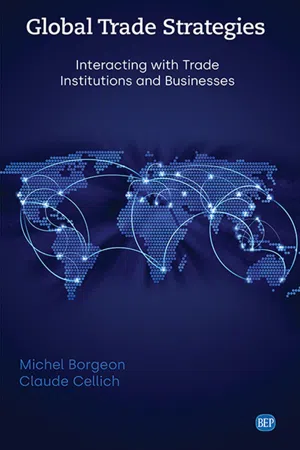![]()
CHAPTER 1
International Trade Promotion: Why and How
With the progressive liberalization of markets on the long term, the globalization process implies for local firms as well as for governments more and stiffer competition, at home as well as on the international marketplace.
Now more than ever, the competitive advantages that any firm or country possesses become smaller and less durable. Enterprise managers are facing realities: becoming globally competitive, pursuing new commercial opportunities (in line with the market liberalization), or conduct “business as usual,” with inevitably diminishing sales and profit.
At national level, the long-term implications are also dramatic. In any country, and more specifically, the concerned government, establishes and maintains a business environment (even in an increased international competition) in order to encourage local entrepreneurs to invest, to help increasing employment, to generate specialized skills and support innovation and new technologies, with the goal of making profits (fairly taxed) and finally to become a competitive global player.
If none of the above, the business sector will suffer and will not be able to take advantage of emerging international export opportunities and trade performance will inevitably deteriorate. This is a particularly challenging scenario for the public-sector planner and strategy-maker in a developing or transition economy. There, the private sector may be fragile, with day-to-day survival concerns rather than long-term development, and would be unable to take any kind of leadership role in response to the rigors of new global competition. Therefore, the challenge is introducing and managing an effective national export strategy (NES).
How to proceed? Two steps are proposed:
- Identify some basic principles
- Analyze examples of best practices (selected case studies developed in Chapter 8).
What should a national export development strategy encompass, in the dynamics of today’s international markets? Should it focus on market development, improving traditional promotional instruments, like trade fair participation, trade missions, and commercial representation services in foreign markets, or should NES concentrate on delivery of more efficient public-sector services that address “persistent market failings,” such as the reluctance of the prospective exporters.
These trade support institutions may have recurrent obligations to:
- purchase information,
- cover initial market contact and exploration costs, and
- invest in technological innovations.
This should be coupled with NES promotional initiatives, organized on behalf of existing enterprises, combined with on-profile programs designed to generate new export capacities.
Assuming that there is a need for the local business community to achieve international standards of competitiveness, the way forward consists in expanding the export strategy equation for inclusion of all the factors relevant to reduce the cost of the export transaction, which means:
- improving forward and backward linkages within and among local industries, generating higher value-added production capacities,
- helping companies to acquire new technologies, and
- developing new, export-oriented competencies.
However, for an NES, to be effective, it must be comprehensively integrated into the overall economic planning framework. It should not simply deal with offshore market development and promotion, but should integrate the longer-term onshore challenges of establishing a national competitiveness framework, creating an export culture and national consensus, thus developing new export industries.
Of course, this building process implies a clear policy statement and orientation: such a choice is obvious for small or limited resources countries (e.g., Singapore), but not so for the large ones (Brazil, Indonesia, even the United States, for which exports represent a relatively smaller share of GDP component).
In short, export strategy should address the issue of current and future international competitiveness throughout the country’s supply chain.
This leads to the conclusion that the process of managing NES implies the direct and substantive involvement of all relevant ministries in the strategy management process: industry, agriculture, transport and public utilities, labor, education, foreign affairs and, of course, finance, with interministerial consultations at the highest level of decision making.
Then comes the fundamental issue of the public–private sector partnership.
For the strategy to work, the private sector is a key, if not the key player for the implementation of the strategy, which must be fully involved in the overall process—not just consulted but involved.
The private sector must ”buy in” and feel responsible for the success or failure of the strategy. If this is obvious and well understood in many open markets countries, it is more difficult to put into practice in some “transition” economies with the former state trading companies.
The next step concerns the process of strategy development and management, reviewing the basic question of leadership and ownership.
- Should trade development strategy management be a top-down responsibility (i.e., government-directed) or a bottom-up exercise (business-led)?
- Should the initiative shift as strategy moves through the design, implementation, and evaluation/refinement phases? What are the institutional implications?
One must look at the entire competitiveness platform.
—Michael Czinkota, George Washington University, Washington, D.C.
There is a need to review the type of institutional linkages and functional relationships needed to ensure that a broad-based strategy is effectively formulated, implemented, and reflected in the initiatives of organizations directly involved in the export development effort.
The goal is to build national consensus and commitment, and to maintain functioning partnerships at the strategic level within the public sector, between the public and private sector, among trade institutions, and within the business community.
Generally, the public-private sector linkage in strategy development is weak, it lacks structure.
—Cecil Jowell: Private Sector Initiative for Export Promotion, Cape Town, South Africa.
There is a need to look at the implications of the fully integrated app...
